1.
Which of the following sources of energy is non-renewable?
I. Coal
II. Solar
III. Wind
IV. Uranium-236
I, II and III only
II, III and IV only
I and IV only
II and III only
2.
The building block of a material with the smallest unit of matter that retains the properties of an element is
an ion.
an atom.
a molecule.
a proton.
3.
Oil from a mechanic workshop accidentally spilled into a pool of water which was breeding mosquitoes.
After sometime, the pool of water was no longer breeding mosquitoes.
Which control method may have been deployed?
Biological control
Chemical control
Environmental control
Genetic control
4.
Grasshopper management is crucial because of all the following reasons except
damage to crops.
incomplete metamorphosis.
ecosystem disruption.
livestock harm.
5.
A hunter experiences a backward force upon firing a gun. Which of the Newton's laws of motion is demonstrated in the situation?
First law
Second law
Third law
Law of inertia
6.
Which of the following sets of devices operate on the principle of magnetism?
Loudspeakers, compass, alarms
Loudspeakers, alarms, LCD TV
Compass, loudspeakers, LCD TV
Compass, loudspeakers, LCD TV
7.
Which of the following elements has four electron shells?
19K
13Al
15P
5B
8.
A livestock farmer wants to achieve good health for animals being reared.
Which of the following activities should be undertaken by the farmer?
I. Have vaccination schedules for the animals
II. Provide balanced ration to the animals
III. Provide good sanitation for the animals
I and II only
II and III only
I and III only
I, II and III
9.
Canned foods and drinks have expiry dates on them. The hazard involved in taking an expired drink is
food poisoning.
impaired hearing.
poor circulation of blood.
suffocation.
10.
Two unknown solutions labelled A and B were brought to a JHS 3 class. It was observed that in solution A, red litmus paper changed colour to blue, whiles in solution B, red litmus paper retained its colour. What could be the content of solution A?
Car battery fluid
Salt solution
Baking soda
Orange juice
11.
A student who complained of stomach upset was given first aid with Mg(OH)2 boldly written on it. What could be the common name of the first aid the student was given?
Milk of aluminium
Milk of magnesia
Trisilicate
Martins liver salt
12.
A bowl of water on a gas stove was initially cold. It became warm after sometime.
What was the mode of heat transfer in the water?
Convection
Radiation
Emission
Conduction
13.
The portion of air which acts as a solvent is
oxygen.
carbon (IV) oxide.
nitrogen.
an inert gas.
14.
A natural phenomenon that illustrates the dispersal of light is
a rainbow.
an eclipse.
a rainfall.
an echo.
15.
When a stick is dipped into a pool of water, it appears to
be longer than its length.
ben away from the surface.
be seen straight in the water.
bend towards the surface.
16.
Which of the following electrical appliances can convert electrical energy to heat energy?
I. Electric iron
II. Kettle
III. Water heater
I, II and III
I and III only
II and III only
I and II only
17.
The consequences of the greenhouse effect on humans include
I. flooding of coastal cities
II. desertification of fertile areas
III. increased number of storms
IV. increased use of fossil fuels
I, II, III and IV
II and III only
I, II and III only
I and II only
18.
Cockroaches in a cupboard were killed after an insecticide had been sprayed. The insecticide reached the cockroaches by the process of
osmosis.
absorption.
diffusion.
radiation.
19.
Which of the following nursery beds is suitable for a flood prone area?
Plain bed
Sunken bed
Raised bed
Flat bed
20.
Which of the following natural cycles directly involves the sun?
I. Carbon cycle
II. Water cycle
III. Nitrogen cycle
I, II and III
I and II only
II and III only
I only
21.
The primary purpose of respiration in man is to
I. take in oxygen.
II. release carbon dioxide.
III. regulate body temperature.
I, II and III
I and II only
II and III only
I and II only
22.
Nitrogen deficiency in soils causes
poor seed formation.
yellowing of leaves.
purple colouration.
fruit drop.
23.
An electric bulb is rated 0.5 A, 120 V. Determine the power produced when the bulb is turned on.
60 kW
60 W
30 kW
30 W
24.
The following processes are chemical changes except
crumpling of paper.
burning of wood.
mixing of an acid and a base.
rusting of iron.
25.
Which of the following statements best describes the term green economy? It includes
reduced ecological services.
loss of biodiversity.
reduced carbon emissions.
degrading the environment.
26.
The energy transformation that occurs when sodium hydroxide is dissolved in water is
heat to potential energy.
chemical to light energy.
chemical to heat energy.
heat to kinetic energy.
27.
Digestion of rice in humans starts from the
stomach.
gullet.
mouth.
colon.
28.
A substance that could be used in large scale treatment of domestic water is
Nitrogen.
Hydrogen sulphide.
Carbon dioxide.
Chlorine.
29.
Chlorophyll helps plants absorb energy from the sun as they undergo the process of photosynthesis. It is located in a structure called
chloroplast.
mitochondrion.
vacuole.
nucleus.
30.
An electrical engineer was in your school to replace a 20 W bulb with a 50 W bulb.
Use this information to answer the question below
The unit inscribed on the bulb measures its
energy.
workdone.
power.
electricity.
31.
An electrical engineer was in your school to replace a 20 W bulb with a 50 W bulb.
Use this information to answer the question below
The 50 W bulb is likely to
I. increase the brightness in the room.
II. increase the amount of electricity consumed.
III. destroy the habitat of pests.
I, II and III
I and III only
II and III only
I and II only
32.
The following devices work based on the principle of pressure in fluids except
siphons.
flutes.
drinking straws.
water pumps.
33.
In making ornaments and jewellery, non-reactive metals are preferred because they
are corrosive.
are attractive.
do not retain their lustre.
do not react with atmospheric oxygen.
34.
A metallic saddle was left in a boiling soup. After sometime, the handle became hot.
This is because the particles in the saddle
undergo rapid, random motion,
contain free electrons which are able to transfer heat energy.
are separated by large distances.
circulate as a result of the temperature differences.
35.
The simplest way of making well water suitable for laundry is by
adding copper sulphate.
filtering.
boiling .
adding chlorine.
36.
A poultry farmer observed that the layers were producing thin-shelled eggs.
Use this information to answer the question below
The defect identified is mostly caused by a deficiency in
zinc..
photospheres..
magnesium.
calcium.
37.
A poultry farmer observed that the layers were producing thin-shelled eggs.
Use this information to answer the question below
What ingredient could be added to the feed to correct the defect?
Maize
Soya bean meal
Cowpea
Oyster shell meal
38.
Which of the following pairs of energy sources is environmentally friendly?
Coal and thermal energy
Wind and biogas
Wind and coal
Biogas and thermal energy
39.
A student is to measure 20 cm3 of a sodium hydroxide solution. What instrument could be used?
Measuring tape
Hygrometer
Measuring cylinder
Hydrometer
40.
A mother took her child to the hospital and upon investigation, it was noticed that the child's diet was lacking in zinc. What could this result in?
I. Decreased growth in the child
II. Anaemia and constipation
III. Inability of the body to fight infection
I, II and III
I and III only
II and III only
I and II only
This paper is in two sections: A and B. Answer Question 1 in Section A and any other three questions in Section B.
Answer all the questions in your answer booklet.
Credit will be given for clarity of expression and orderly presentation of material.
Answer all questions in this section
(a)
Fig. 1(a) is an illustration of the longitudinal section of the mammalian heart.
Study it carefully and answer the questions that follow
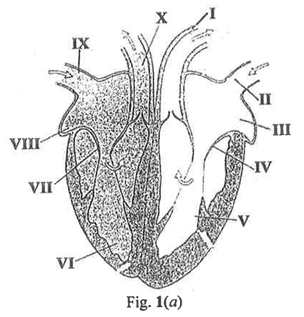
(i)
State one function for each of the parts labelled I, II, IX and X.
(ii)
Explain briefly why the left lower part of the heart has a thicker muscle.
(iii)
State two ways by which the flow of blood to and from the mammalian heart as shown in Fig 1(a) can be kept at acceptable levels.
(iv)
Name two parts of the heart where oxygenated blood can be found.
(b)
Fig. 1(b) is an illustration of three sets of plant parts labelled P(maize grains), Q(tomato seedlings) and R(cassava cutting).
Study it carefully and answer the questions that follow

(i)
Describe briefly how each of the parts labelled P, Q and R are planted on seedbed.
(ii)
State four conditions under which R can be cultivated to produce high yield.
(c)
Fig. 1(c) is an electric circuit diagram
Study it carefully and answer the questions that follow
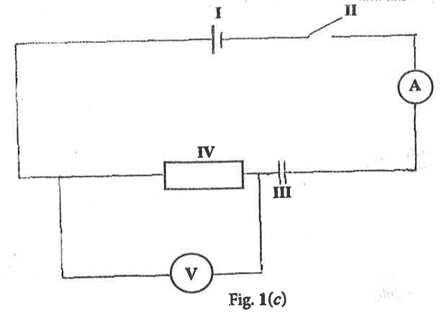
(i)
State one function for each of the parts labelled I, II, III and IV.
(ii)
If the voltmeter reads 2.4 V and the ammeter reads 0.8 A when the circuit is closed, calculate the value of the part labelled IV.
(iii)
State one way of conserving the value of the part labelled I in the circuit.
(iv)
State two observations that can be made when the circuit is closed.
(d)
Fig. 1(d) illustrates an experiment performed to separate the components of a mixture.
Study it carefully and answer the questions that follow

(i)
Describe briefly the process of this experiment.
(ii)
State one function for each of the parts labelled II and IV.
(iii)
State two precautions that should be taken to obtain reliable results when performing this experiment.
Answer three questions only from this section
(a)
(i)
Given a flashlight, a tennis ball and a screen, draw a diagram to show how a shadow can be formed.
(ii)
A student seeking to determine the volume of an irregular body of mass 4 kg used a graduated cylinder in an experiment.
Fig. 2 illustrates two key stages of the experiment where A indicates a setup before the irregular body was immersed and B indicates the same setup after the irregular body was immersed.
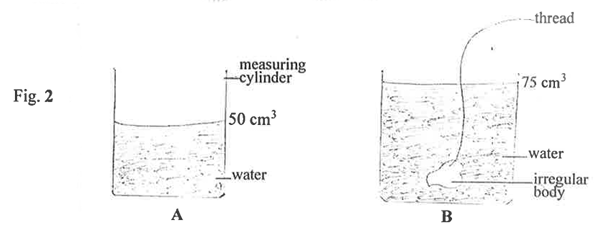
Determine the density of the irregular body.
(iii)
State two precautions that must be taken to obtain reliable results.
(b)
State three safety precautions to prevent accidents during the use of liquefied petroleum gas in the home.
(c)
Explain briefly the scientific princible underlying each of the following waste management practices:
(i)
Composting;
(ii)
Recycling;
(iii)
Incineration.
(d)
The digestive system of two domestic animals were provided. One is that of a goat and the other is that of a rabbit.
Outline three features that would help to differentiate between the two digestive systems.
(a)
You have been given maize, cowpea, cassava and cabbage to cultivate on a piece of land using crop rotation system.
(i)
Design a 4-year rotational program using the given crops.
(ii)
Give two reasons for the sequence given in (a)(i).
(b)
A student is suspected of having contracted COVID-19.
(i)
Give three symptoms that the student may exhibit to confirm this suspicion.
(ii)
Suggest two ways to prevent the spread of COVID-19 in the school.
(iii)
Give two reasons why COVID-19 was declared as a pandemic.
(c)
The mass of a vehicle is 1000 kg and travels at 100 m s-1. If the vehicle accelerates to 150 ms-1 in 10 s, calculate the:
(i)
acceleration of the vehicle;
(ii)
force that acts on the vehicle;
(iii)
final momentum when the vehicle comes to a stop.
(a)
A student who went to bed immediately after eating complained of stomach upset the next morning. A doctor prescribed a liver salt, whose major composition is NaHCO3 as the medication.
Using a balanced chemical equation, explain how the liver salt would relieve the student from this discomfort.
(b)
Fig. 4 is an illustration of a body of mass 20 kg placed on top of a wall of height 10 m.
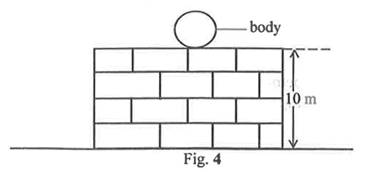
Calculate the energy of the body.
(c)
(i)
Define the term light emitting diode (LED).
(ii)
Mention two devices that use LED in their operation.
(d)
A student was tasked to prepare a raised nursery bed for nursing tomato seeds:
(i)
Suggest two simple tools that could be used in the nursery bed preparation;
(ii)
State one function each of the tools listed in (d(i).
(e)
(i)
State three observable features of an animal cell.
(ii)
State two functions of a nerve cell.
(a)
Fig. 5 is an electrical circuit diagram.
Study it and answer the questions that follow.
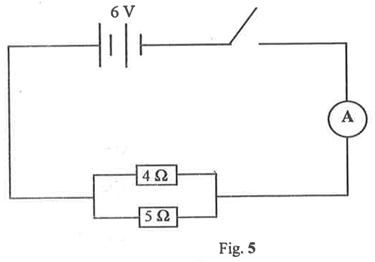
Calculate the:
(i)
effective resistance in the circuit when it is closed;
(ii)
current that will flow through the circuit when it is closed.
(b)
(i)
Differentiate between an organic fertilizer and an inorganic fertilizer.
(ii)
Outline briefly the steps involved in preparing raised beds.
(c)
(i)
State one function each of the following components of blod:
(α)
red blood cells;
(β)
white blood cells;
(γ)
blood plasma.
(ii)
Explain briefly the impact of each of the following organisms on humans:
(α)
housefly;
(β)
grasshopper.
(d)
Describe briefly the formation of an ammonia molecule after an interaction between 1H and 7N atoms.